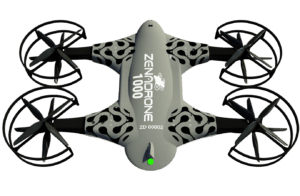Zena Drone has helped revolutionize the burgeoning hemp industry. In this guest post, Leah Jacobe outlines five ways that intelligent drones in the agriculture sector are helping growers to meet the demands of global food production.
The following is a guest post by Leah Jacobe, Media Team Leader at Zena Drone, a leading producer of small AI-driven commercial drones revolutionizing the hemp industry. DRONELIFE neither accepts nor makes payments for guest posts.
The increasing demand for global food supply has led the agriculture sector to seek methods to speed up food source production. Regular monitoring, tracking, and surveillance of food plantations and livestock tracking are critical in ensuring consistent yield harvest outcomes. Technological innovation such as unmanned aerial vehicles (UAV) or drones is vital in securing the global food supply.
Drones are seeing more use in several industries, especially in agribusiness, because of their capability to survey and monitor vast areas quickly. Not only do they save time and resources, but they also optimize many processes and even ensure workplace safety.
Five Uses of Drones in the Agriculture Sector
No drone technology is one size fits all, but some drones have multiple uses across industries. There are drones for mission-critical purposes like in the military. There are entertainment drones for filming movies or following news stories. And then there are drones for commercial and personal use.
Multi-faceted drone applications are beneficial to the modern world, especially in securing food sources worldwide.
For growers, here are five ways drones can help improve outcomes:
1) Surveying Fruits, Crops, and Livestock
Most drones, if not all, are fitted with a high-definition camera, multiple scanners, thermal imaging, and geotagging capabilities. These components allow drones to capture accurate, comprehensive, and vivid data on plant health from seed to harvest. Farmers can ensure the harvest yield using drone monitoring technology.
2) Capturing of High-definition Photo and Video
It is vital to track plant growth in farming. When you manage vast acres of farm, it can be challenging to conduct daily inspections of soil condition, plant hydration status, and amount of fertilizer needed. Innovative drones can ease up monitoring and assessment with their integrated high-definition cameras.
The farmers can quickly act on emerging problems and threats to the plantations by capturing accurate field information. They can adjust irrigation and the volume of fertilizers depending on their assessment of the given data.
3) 3D Mapping of Terrain
One particular use of drones is to make 3D maps. Drones create highly detailed maps with depth, topographic attributes, and critical land measurements for agricultural purposes. Farmers can use this essential data to determine soil and topographic conditions conducive to optimum crop growth.
4) Plant and Animal Tracking using Drone Multispectral Sensors
Drone capabilities have evolved in recent years. At present, there are smart agricultural drones that can track animals, tag plant genders, and scan plant vitality. Thanks to multispectral sensors embedded in smart farming drones, plant and animal monitoring, as well as tracking are more effective and efficient.
Farmers can easily find lost or trapped animals using drone tagging features. The drone can register body heat signatures and provide GPS coordinates allowing livestock movement tracking. They can synchronize animal GPS tags with the drone multispectral and geotagging sensors to quickly locate lost livestock.
Moreover, drones’ multispectral sensors can determine male and female plants, especially in hemp farming, where it is vital to separate the female plants from the males to increase crop harvest. Hemp has CBD oil components beneficial to a lot of medical conditions.
Sunlight, humidity, and wind sensors record weather conditions allowing farmers to predict seasons and climate changes. These intelligent sensors help forecast the weather prompting farmers to secure their crops early on in case of incoming heavy winds and rain that may ruin the crops.
5) Seed Planting and Plant Spraying
Drones may be small aerial vehicles, but they come with plenty of uses. Agricultural drones with customizable attachments allow farmers to attach automatic fertilizer sprayers and seed dispersal mechanisms.
Coated seeds can be loaded into the canister and attached to the drone. The pilot can select the location for seed planting and release the seeds with the push of a button on the drone controller. This method of planting is beneficial and efficient in reforestation efforts, especially in critically endangered protected forests.
Fertilizer aerial spraying has been a farming practice for several years. But this method of planting entails renting lightweight aircraft, which comes with a hefty price and safety hazards to nearby residents. Although very rare, light planes risk crashing onto persons and properties and cause liability from damages: however, unmanned aerial vehicles (UAV) are too tiny to cause massive damage when they crash on the ground.
The ZenaDrone 1000: Collaborating with Hemp Farmer to Develop Drones for the Agriculture Sector
Drones are emerging and evolving according to use. There are drones with a specific purpose for cargo, delivery, and logistics. They serve commercial businesses. Consequently, drones with high-definition cameras for precision surveillance in the Military sector. Entertainment and Media drones are also popular among movie makers.
The ZenaDrone 1000 is an intelligent unmanned aerial vehicle (UAV) that incorporates machine learning software and artificial intelligence (AI). It revolutionized the hemp farming sector and later evolved into a multi-functional industrial smart drone.
ZenaDrone 1000 comprises innovative software technology and compact hardware components designed for industrial uses in construction, agriculture, surveillance, search and rescue, environmental inspection, and customizable functionalities.
Dr. Shaun Passley, CEO, and Director of ZenaPay, Inc, teamed up with hemp farmers in Ireland to develop the ZenaDrone agricultural drone technology. They saw a need for agricultural innovation and committed to using intelligent drones to help the farmers produce high-quality crop harvest and premium agricultural products.
In the present day, ZenaDrone has helped increase hemp farm harvest, prompting other agricultural companies to use the technology in their farming practices.
The Takeaway
Drone technology provides infinite practical uses to various industries. Hence, these modern drones’ customizability adds more functions and features that make it easier to understand, access, and operate. Drone use has a substantial impact on global food production. With the benefits that UAVs provide, securing sustainable farming methods can serve both the farmers and the environment.
Drones are small, compact, and robust agricultural machines making it easier for farmers to cut losses, preserve resources, and optimize crop harvest using accurate information.
Read more about drones in agriculture:
- Drones in Agriculture Worth More than $5 Billion by 2025
- Can Drones Compete with Satellite Images? How BVLOS Will Change Global Agriculture
- Drone Data Experts Pix4D Speak at UN Panel on Food Security
- Can Drone Technology Be a Game Changer for the Food Supply Chain?
- Precision Ag Reaches New Heights: Accelerating Plant Breeding and Variety Testing with Drone Data
- Drones and Centipedes: Brazilian Farmers Adopt Precision Agriculture with SimActive
 Leah is a highly passionate, curious, and free-spirited Team Leader of the Content Writing team and Social Media team of ZenaDrone, Inc. When she’s not mentoring, training, and coaching the writers, she reads legal cases and legal concepts for law school. When time permits, she loves watching sci-fi movies with her husband and daughter while binge-eating on popcorn with cheese. Reach Leah on her social channels listed below:
Leah is a highly passionate, curious, and free-spirited Team Leader of the Content Writing team and Social Media team of ZenaDrone, Inc. When she’s not mentoring, training, and coaching the writers, she reads legal cases and legal concepts for law school. When time permits, she loves watching sci-fi movies with her husband and daughter while binge-eating on popcorn with cheese. Reach Leah on her social channels listed below:
Social Media Account: https://www.facebook.com/profile.php?id=100079164337285
Twitter: https://twitter.com/leahjacobe
LinkedIn: https://www.linkedin.com/in/leah-jacobe-89b76021/
Miriam McNabb is the Editor-in-Chief of DRONELIFE and CEO of JobForDrones, a professional drone services marketplace, and a fascinated observer of the emerging drone industry and the regulatory environment for drones. Miriam has penned over 3,000 articles focused on the commercial drone space and is an international speaker and recognized figure in the industry. Miriam has a degree from the University of Chicago and over 20 years of experience in high tech sales and marketing for new technologies.
For drone industry consulting or writing, Email Miriam.
TWITTER:@spaldingbarker
Subscribe to DroneLife here.








[…] Supply hyperlink […]